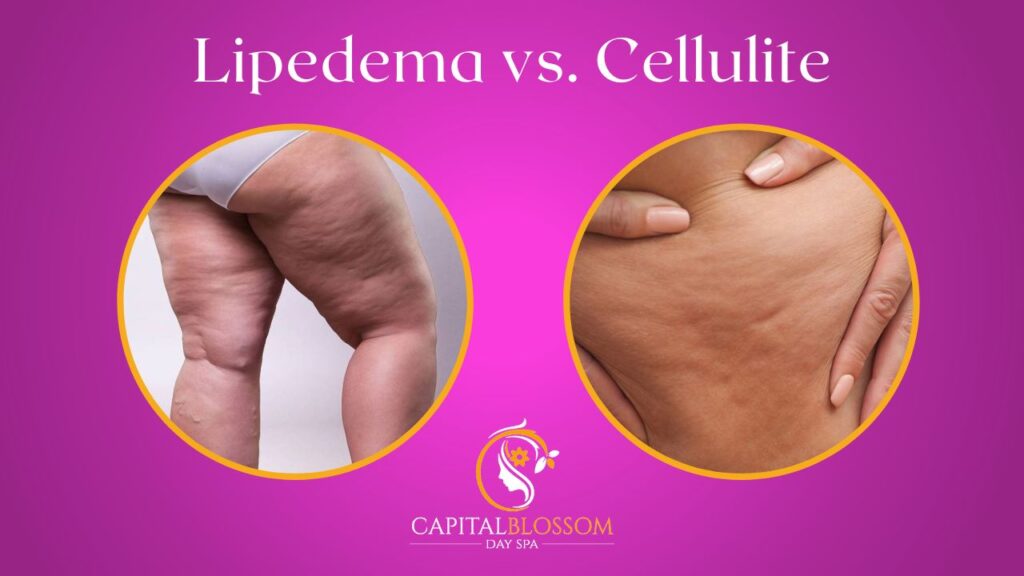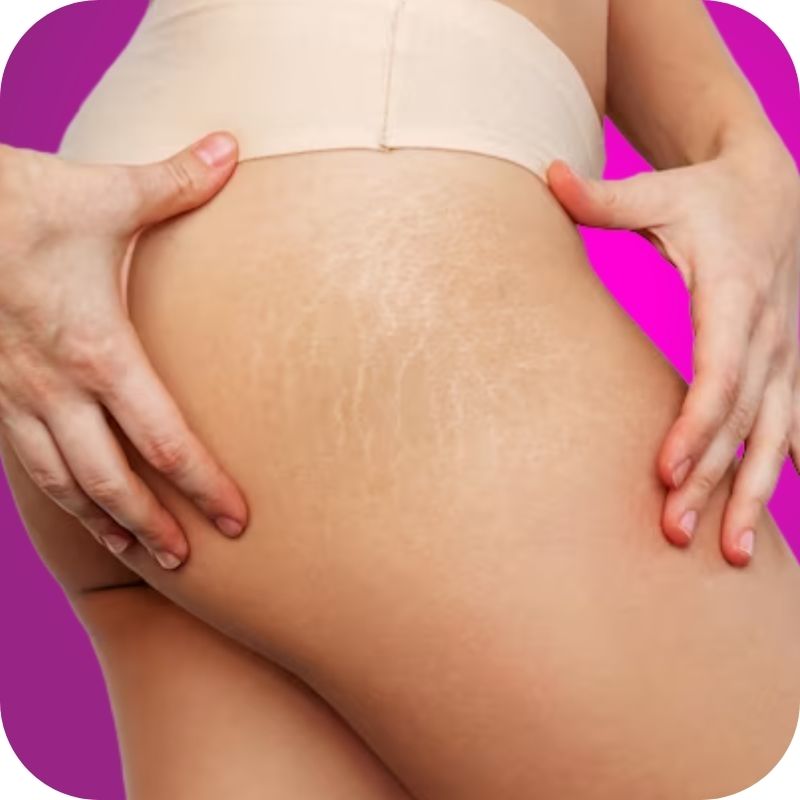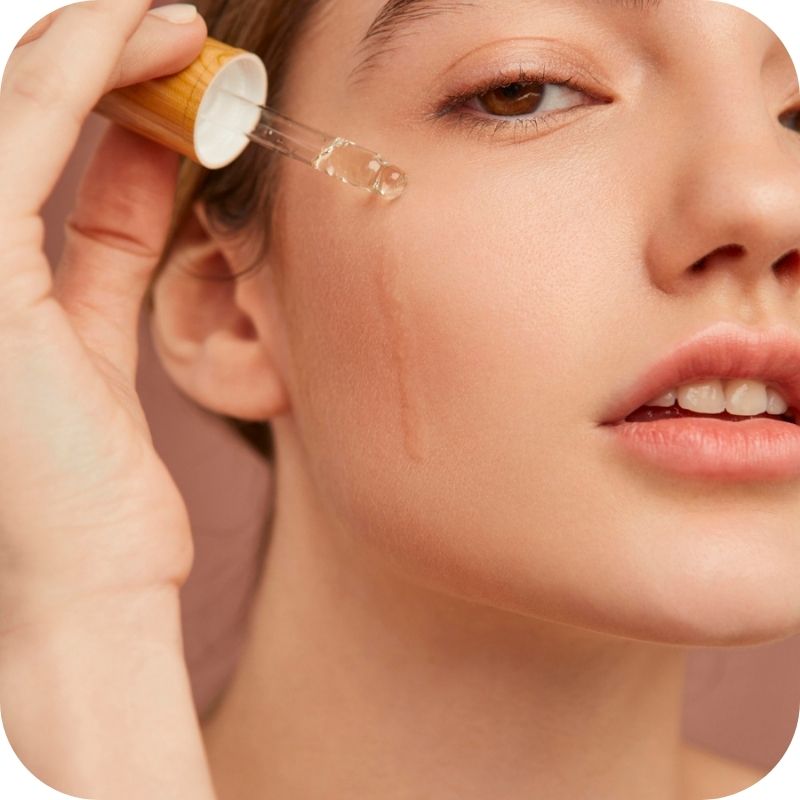
Lipedema vs. Cellulite – How to Differentiate and Address Each Condition
Struggling with concerns about your legs and wondering whether it’s lipedema or cellulite causing the unease?
Many individuals find themselves grappling with the nuances between these two conditions.
So, let’s unravel the intricacies of lipedema vs. cellulite, exploring how they differ and understanding how to address each one.

Difference Between Lipedema vs. Cellulite
Starting with the basics, lipedema and cellulite may share the stage on the surface, but their roots are distinct.
Lipedema is a chronic condition where there’s an abnormal accumulation of fat, primarily in the lower limbs.
It’s often characterized by a disproportionate increase in fat, creating a distinct “column-like” appearance.
On the other hand, cellulite is a common cosmetic concern, distinguished by the dimpling or “orange peel” texture on the skin’s surface.
It results from the interaction between connective tissue and fat beneath the skin, giving rise to those telltale dimples, often seen on the thighs and buttocks.
Now, let’s dive deeper into the characteristics that set lipedema and cellulite apart.
Symptoms and Signs
Lipedema typically manifests with bilateral and symmetrical fat deposition in the legs, sparing the feet.
It may extend from the hips to the ankles, creating a distinct demarcation between the affected area and the hands and upper body.
Cellulite, on the other hand, presents as a textural change on the skin. The classic dimpling or cottage cheese-like appearance is more evident when pressure is applied to the affected area.
It’s essential to note that cellulite is incredibly common and can affect individuals of all body types.
Root Causes
Understanding the origins of these conditions is crucial for effective management. Lipedema is often considered a genetic disorder, with hormonal factors potentially playing a role.
It predominantly affects women and may be triggered or exacerbated by hormonal changes, like those during puberty or pregnancy.
Cellulite, on the contrary, is primarily associated with connective tissue and aging.
Changes in the connective tissue structure, coupled with lifestyle factors like poor diet and lack of exercise, contribute to the development of cellulite.
Genetics also play a role, with some individuals being more predisposed to cellulite than others.

Addressing Lipedema
If you suspect you may have lipedema, seeking professional medical advice is crucial. Diagnosis often involves a clinical evaluation, including a detailed medical history and physical examination.
While there is no cure for lipedema, various management strategies can help alleviate symptoms and improve quality of life.
Compression Therapy – Wearing compression garments can provide support and help reduce swelling associated with lipedema.
Physical Therapy – Targeted exercises, particularly those focusing on lymphatic drainage, may be beneficial.
Healthy Lifestyle – Maintaining a balanced diet and staying physically active are integral to managing lipedema symptoms.
Tackling Cellulite
Cellulite, being a cosmetic concern, often prompts individuals to explore ways to minimize its appearance.
While there’s no foolproof solution, certain lifestyle changes and treatments can make a difference.

Healthy Diet
A nutritious diet can play a significant role in addressing cellulite. Choosing foods rich in fruits, vegetables, and lean proteins provides essential nutrients that support skin health.
These foods can aid in reducing inflammation and improving the overall texture of your skin.
On the other hand, processed foods and excessive sugar consumption are known to contribute to weight gain and inflammation, both of which can make cellulite more prominent.
Regular Exercise
Incorporating regular physical activity into your routine is crucial not only for maintaining a healthy weight but also for promoting overall well-being.
Exercise helps in burning excess fat, toning muscles, and improving blood circulation.
Engaging in cardiovascular and strength-training exercises can be particularly effective in reducing the appearance of cellulite.
Topical Treatments
Some individuals find creams or serums containing ingredients like caffeine or retinol helpful in improving skin texture.
At Capital Blossom Day Spa, we offer a range of topical treatments designed to complement your efforts in achieving smoother and more radiant skin.
Medical Procedures
In cases where cellulite concerns are more significant or stubborn, individuals may consider medical interventions such as laser therapy or radiofrequency treatments.
These procedures, offered by professionals at places like Capital Blossom Day Spa, are designed to target cellulite and improve skin texture.
They work by stimulating collagen production, promoting blood circulation, and breaking down fat deposits beneath the skin.
While these treatments can provide more immediate results, they are typically best combined with a healthy lifestyle to maintain long-term improvements.

Professional Guidance for Lipedema vs. Cellulite Concerns
When it comes to managing and differentiating between lipedema and cellulite, recognizing the distinct characteristics, symptoms, and root causes of each is essential.
Seeking professional advice and understanding the condition you’re dealing with is the first step in finding effective management strategies.
Whether you’re seeking to address concerns related to lipedema or cellulite, Capital Blossom Day Spa offers a range of specialized treatments and personalized advice to help you on your path to smoother, more radiant skin.
Don’t let uncertainties about these conditions hinder your confidence.
Reach out to us to schedule a consultation and start your journey towards healthier skin today.